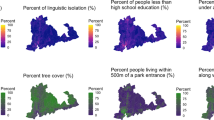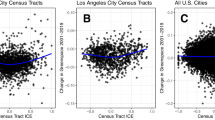Abstract
Urban green space, or natural environments, are associated with multiple physical and mental health outcomes. Several proposed pathways of action for these benefits (e.g., stress reduction and attention restoration) require visual perception of green space; however, existing green space exposure measures commonly used in epidemiological studies do not capture street-scale exposures. We downloaded 254 Google Street View (GSV) panorama images from Portland, Oregon and calculated percent of green in each image, called Green View Index (GVI). For these locations we also calculated satellite-based normalized difference vegetation index (NDVI), % tree cover, % green space, % street tree buffering, distance to parks, and several neighborhood socio-economic variables. Correlations between the GVI and other green space measures were low (−0.02 to 0.50), suggesting GSV-based measures captured unique information about green space exposures. We further developed a GVI:NDVI ratio, which was associated with the amount of vertical green space in an image. The GVI and GVI:NDVI ratio were weakly related to neighborhood socioeconomic status and are therefore less susceptible to confounding in health studies compared to other green space measures. GSV measures captured unique characteristics of the green space environment and offer a new approach to examine green space and health associations in epidemiological research.
This is a preview of subscription content, access via your institution
Access options
Subscribe to this journal
Receive 6 print issues and online access
$259.00 per year
only $43.17 per issue
Buy this article
- Purchase on Springer Link
- Instant access to full article PDF
Prices may be subject to local taxes which are calculated during checkout






Similar content being viewed by others
References
Shanahan DF, Bush R, Gaston KJ, Lin BB, Dean J, Barber E, et al. Health benefits from nature experiences depend on dose. Sci Rep. 2016 https://www.ncbi.nlm.nih.gov/pmc/articles/PMC4917833/
Astell-Burt T, Feng X, Kolt GS. Is neighborhood green space associated with a lower risk of type 2 diabetes? Evidence from 267,072 Australians. Diabetes Care. 2014;37:197–201.
Ebisu K, Holford TR, Bell ML. Association between greenness, urbanicity, and birth weight. Sci Total Environ. 2016;542:750–6.
Beyer KM, Kaltenbach A, Szabo A, Bogar S, Nieto FJ, Malecki KM. Exposure to neighborhood green space and mental health: evidence from the survey of the health of Wisconsin. Int J Environ Res Public Health. 2014;11:3453–72.
Bratman GN, Hamilton JP, Daily GC. The impacts of nature experience on human cognitive function and mental health. Ann N Y Acad Sci. 2012;1249:118–36.
Takano T, Nakamura K, Watanabe M. Urban residential environments and senior citizens’ longevity in megacity areas: the importance of walkable green spaces. J Epidemiol Community Health. 2002;56:913–8.
Baró F, Chaparro L, Gómez-Baggethun E, Langemeyer J, Nowak DJ, Terradas J. Contribution of ecosystem services to air quality and climate change mitigation policies: the case of urban forests in Barcelona, Spain. Ambio. 2014;43:466–79.
Maimaitiyiming M, Ghulam A, Tiyip T, Pla F, Latorre-Carmona P, Halik Ü, et al. Effects of green space spatial pattern on land surface temperature: Implications for sustainable urban planning and climate change adaptation. ISPRS J Photogramm. Remote Sens. 2014;89:59–66.
Lottrup L, Grahn P, Stigsdotter UK. Workplace greenery and perceived level of stress: Benefits of access to a green outdoor environment at the workplace. Landsc Urban Plan. 2013;110:5–11.
Coombes E, Jones AP, Hillsdon M. The relationship of physical activity and overweight to objectively measured green space accessibility and use. Soc Sci Med. 2010;70:816–22.
Wendel HEW, Zarger RK, Mihelcic JR. Accessibility and usability: Green space preferences, perceptions, and barriers in a rapidly urbanizing city in Latin America. Landsc Urban Plan. 2012;107:272–82.
Lovasi GS, Schwartz-Soicher O, Quinn JW, Berger DK, Neckerman KM, Jaslow R, et al. Neighborhood safety and green space as predictors of obesity among preschool children from low-income families in New York City. Prev Med. 2013;57:189–93.
Laumann K, Gärling T, Stormark KM. Selective attention and heart rate responses to natural and urban environments. J Environ Psychol. 2003;23:125–34.
Ulrich RS. Natural versus urban scenes: Some psychophysiological effects. Environ Behav. 1981;13:523–56.
Groenewegen PP, Berg AE, van den, Vries S, de, Verheij RA. Vitamin G: effects of green space on health, well-being, and social safety. BMC Public Health. 2006;6:149.
Li X, Zhang C, Zhang C, Li W, Ricard R, Meng Q, Zhang W. Assessing street-level urban greenery using Google Street View and a modified green view index. Urban Urban. 2015;14:675–85.
Li X, Zhang C, Li W, Kuzovkina YA, Weiner D. Who lives in greener neighborhoods? The distribution of street greenery and its association with residents’ socioeconomic conditions in Hartford, Connecticut, USA. Urban Urban. 2015;14:751–9.
van Rossum G, Drake Jr FL. Extending and embedding Python, Release 2.7. Python Softw Found Wolfeboro Falls. 2010
Bradski G, et al. The opencv library. Dr Dobbs J. 2000;25:120–6.
Moore RT, Hansen MC. Google Earth Engine: a new cloud-computing platform for global-scale earth observation data and analysis. In: AGU Fall Meeting Abstracts; 2011. p. 02. http://adsabs.harvard.edu/abs/2011AGUFMIN43C..02M
Zhu Z, Wang S, Woodcock CE. Improvement and expansion of the Fmask algorithm: cloud, cloud shadow, and snow detection for Landsats 4–7, 8, and Sentinel 2 images. Remote Sens Environ. 2015;159:269–77.
ArcGIS E. 10.3. 1; Environmental Systems Research Institute, Inc. Redlands; 2015
Studio R. RStudio: integrated development environment for R. RStudio Inc. Boston, Massachusetts; 2012
Cusack L, Larkin A, Carozza S, Hystad P. Associations between residential greenness and birth outcomes across texas. Environ Res. 2017;152:88–95.
Acknowledgements
The authors would like to thank Google for developing and maintaining the Google Street View and Google Earth Engine datasets and APIs. The authors would also like to thank Leanne Cusack for her thoughts and contributions while developing presentation materials.
Author information
Authors and Affiliations
Corresponding author
Ethics declarations
Conflict of interest
The authors declare that they have no conflict of interest.
Electronic supplementary material
Rights and permissions
About this article
Cite this article
Larkin, A., Hystad, P. Evaluating street view exposure measures of visible green space for health research. J Expo Sci Environ Epidemiol 29, 447–456 (2019). https://doi.org/10.1038/s41370-018-0017-1
Received:
Revised:
Accepted:
Published:
Issue Date:
DOI: https://doi.org/10.1038/s41370-018-0017-1
Keywords
This article is cited by
-
The green window view index: automated multi-source visibility analysis for a multi-scale assessment of green window views
Landscape Ecology (2024)
-
The Impacts of Visible Green Spaces on the Mental well-being of University Students
Applied Spatial Analysis and Policy (2024)
-
The use of Enhanced Vegetation Index for assessing access to different types of green space in epidemiological studies
Journal of Exposure Science & Environmental Epidemiology (2024)
-
Cyclists’ exposure to air pollution, noise, and greenery: a population-level spatial analysis approach
International Journal of Health Geographics (2023)
-
Critical windows of exposure to air pollution and gestational diabetes: assessing effect modification by maternal pre-existing conditions and environmental factors
Environmental Health (2023)



